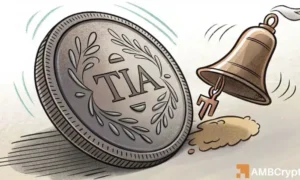Title: Bitcoin Poised for a Surge Amidst Trump’s Tariff Controversies: Market Insights
Introduction
Recent tariff announcements by U.S. President Donald Trump have ignited varied reactions across financial markets, particularly in the cryptocurrency sector. Despite initial concerns, Bitcoin demonstrated remarkable resilience, prompting analysts to predict a potential price surge in the near future. The financial services platform Matrixport has notably acknowledged Bitcoin’s ability to weather the chaos of tariff discussions, emphasizing the cryptocurrency’s growing appeal as a safe haven. In this article, we will explore how current market sentiments and geopolitical factors may influence the future trajectory of Bitcoin.
The Market’s Response to Trump’s Tariffs
Trump’s latest tariffs have elicited mixed responses, generating discontent alongside calls for further negotiations. Treasury Secretary Scott Bessent indicated that these tariffs could mark the beginning of extensive trade negotiations. Notably, despite the turbulent climate spurred by these announcements, Bitcoin has shown remarkable stability, remaining largely unaffected by external financial pressures. As per Matrixport’s analysis, Bitcoin price is currently consolidating below the crucial $90,000 mark, indicating a period of temporary stagnation amidst a backdrop of uncertainty in traditional markets.
Bitcoin’s Current Price Dynamics
As of the latest updates, Bitcoin is trading around $82,486, reflecting a slight decrease of 0.74%. This recent performance includes notable weekly and monthly declines of 2.86% and 8.32%, respectively. Trading volume has also tumbled, with 24-hour figures hitting $39.19 billion, a significant drop of 26.9%. Despite these numbers, analysts remain optimistic about Bitcoin’s long-term potential, particularly as financial markets grapple with the ramifications of Trump’s tariffs.
Potential for Price Surge: Expert Predictions
The prevailing sentiment in the crypto market suggests Bitcoin could be on the cusp of a price uptick, bolstered by its perceived value as a safe haven asset amid market volatility. Analysts, including those from the firm CryptoELITES, are predicting that Bitcoin could rise to $150,000, with earlier targets ranging from a floor of $120,000 to this ambitious prediction set for April and May. This potential surge could be attributed to Bitcoin’s ability to establish itself as a stable investment, particularly in lieu of increased financial uncertainty stemming from geopolitical events.
Impact of Broader Market Trends
Interestingly, while the stock market suffered significant losses due to backlash against the tariffs—erasing approximately $2.85 trillion and witnessing the NASDAQ’s 5.5% drop—Bitcoin managed to close out the day positively. This intriguing correlation suggests that Bitcoin is beginning to decouple from traditional stock market trends, demonstrating its unique position as an alternative investment. Should Bitcoin continue to track positively amidst stock market turmoil, it could serve to further solidify its role as a legitimate asset class for investors.
Conclusion: Bitcoin’s Future Amidst Market Turmoil
In conclusion, Bitcoin’s price dynamics in response to Trump’s tariff announcements exemplify the cryptocurrency’s resilience in a fluctuating market environment. As traders increasingly regard Bitcoin as a potential safe haven, the market sentiment appears to be shifting towards a more optimistic outlook. With forecasts projecting substantial price targets in the coming months, investors may find it advantageous to monitor these developments closely. As the cryptocurrency market continues to adapt and evolve, Bitcoin remains a focal point for both curiosity and investment opportunity.
Disclaimer
This article serves as an informational piece and does not constitute financial advice. Readers are encouraged to conduct their own market research before engaging in cryptocurrency investments, recognizing inherent risks involved. The author or publication does not bear responsibility for any personal financial losses.
















